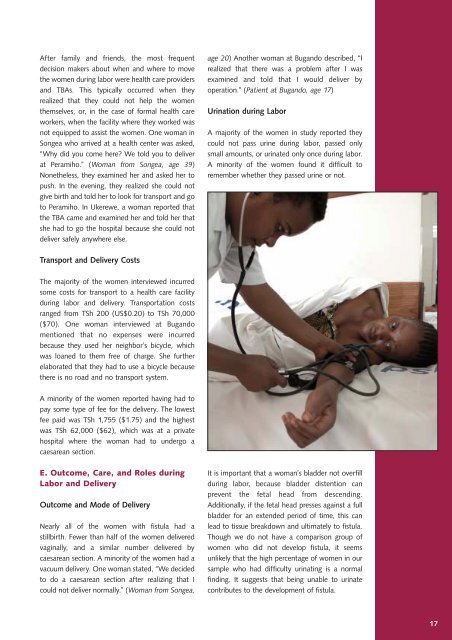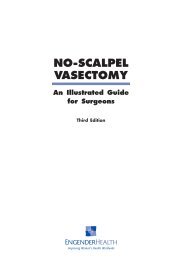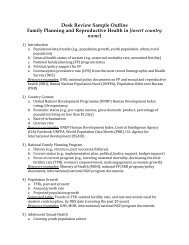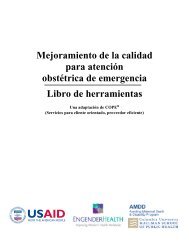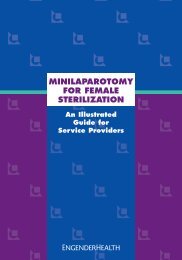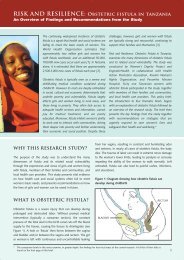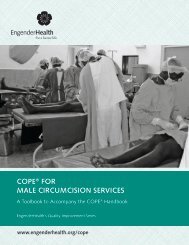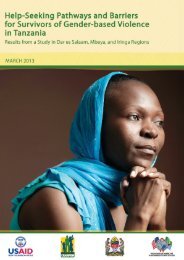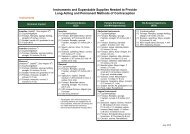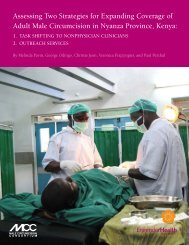Risk and Resilience: Obstetric Fistula in Tanzania - EngenderHealth
Risk and Resilience: Obstetric Fistula in Tanzania - EngenderHealth
Risk and Resilience: Obstetric Fistula in Tanzania - EngenderHealth
You also want an ePaper? Increase the reach of your titles
YUMPU automatically turns print PDFs into web optimized ePapers that Google loves.
After family <strong>and</strong> friends, the most frequent<br />
decision makers about when <strong>and</strong> where to move<br />
the women dur<strong>in</strong>g labor were health care providers<br />
<strong>and</strong> TBAs. This typically occurred when they<br />
realized that they could not help the women<br />
themselves, or, <strong>in</strong> the case of formal health care<br />
workers, when the facility where they worked was<br />
not equipped to assist the women. One woman <strong>in</strong><br />
Songea who arrived at a health center was asked,<br />
“Why did you come here We told you to deliver<br />
at Peramiho.” (Woman from Songea, age 39)<br />
Nonetheless, they exam<strong>in</strong>ed her <strong>and</strong> asked her to<br />
push. In the even<strong>in</strong>g, they realized she could not<br />
give birth <strong>and</strong> told her to look for transport <strong>and</strong> go<br />
to Peramiho. In Ukerewe, a woman reported that<br />
the TBA came <strong>and</strong> exam<strong>in</strong>ed her <strong>and</strong> told her that<br />
she had to go the hospital because she could not<br />
deliver safely anywhere else.<br />
age 20) Another woman at Bug<strong>and</strong>o described, “I<br />
realized that there was a problem after I was<br />
exam<strong>in</strong>ed <strong>and</strong> told that I would deliver by<br />
operation.” (Patient at Bug<strong>and</strong>o, age 17)<br />
Ur<strong>in</strong>ation dur<strong>in</strong>g Labor<br />
A majority of the women <strong>in</strong> study reported they<br />
could not pass ur<strong>in</strong>e dur<strong>in</strong>g labor, passed only<br />
small amounts, or ur<strong>in</strong>ated only once dur<strong>in</strong>g labor.<br />
A m<strong>in</strong>ority of the women found it difficult to<br />
remember whether they passed ur<strong>in</strong>e or not.<br />
Transport <strong>and</strong> Delivery Costs<br />
The majority of the women <strong>in</strong>terviewed <strong>in</strong>curred<br />
some costs for transport to a health care facility<br />
dur<strong>in</strong>g labor <strong>and</strong> delivery. Transportation costs<br />
ranged from TSh 200 (US$0.20) to TSh 70,000<br />
($70). One woman <strong>in</strong>terviewed at Bug<strong>and</strong>o<br />
mentioned that no expenses were <strong>in</strong>curred<br />
because they used her neighbor’s bicycle, which<br />
was loaned to them free of charge. She further<br />
elaborated that they had to use a bicycle because<br />
there is no road <strong>and</strong> no transport system.<br />
A m<strong>in</strong>ority of the women reported hav<strong>in</strong>g had to<br />
pay some type of fee for the delivery. The lowest<br />
fee paid was TSh 1,755 ($1.75) <strong>and</strong> the highest<br />
was TSh 62,000 ($62), which was at a private<br />
hospital where the woman had to undergo a<br />
caesarean section.<br />
E. Outcome, Care, <strong>and</strong> Roles dur<strong>in</strong>g<br />
Labor <strong>and</strong> Delivery<br />
Outcome <strong>and</strong> Mode of Delivery<br />
Nearly all of the women with fistula had a<br />
stillbirth. Fewer than half of the women delivered<br />
vag<strong>in</strong>ally, <strong>and</strong> a similar number delivered by<br />
caesarean section. A m<strong>in</strong>ority of the women had a<br />
vacuum delivery. One woman stated, “We decided<br />
to do a caesarean section after realiz<strong>in</strong>g that I<br />
could not deliver normally.” (Woman from Songea,<br />
It is important that a woman’s bladder not overfill<br />
dur<strong>in</strong>g labor, because bladder distention can<br />
prevent the fetal head from descend<strong>in</strong>g.<br />
Additionally, if the fetal head presses aga<strong>in</strong>st a full<br />
bladder for an extended period of time, this can<br />
lead to tissue breakdown <strong>and</strong> ultimately to fistula.<br />
Though we do not have a comparison group of<br />
women who did not develop fistula, it seems<br />
unlikely that the high percentage of women <strong>in</strong> our<br />
sample who had difficulty ur<strong>in</strong>at<strong>in</strong>g is a normal<br />
f<strong>in</strong>d<strong>in</strong>g. It suggests that be<strong>in</strong>g unable to ur<strong>in</strong>ate<br />
contributes to the development of fistula.<br />
17


